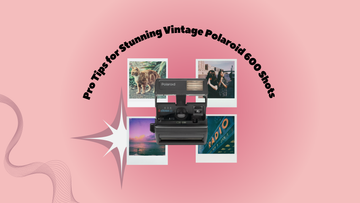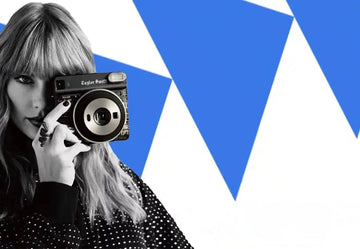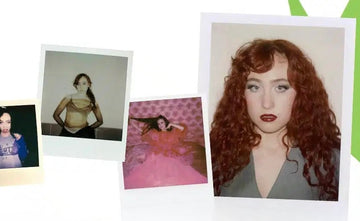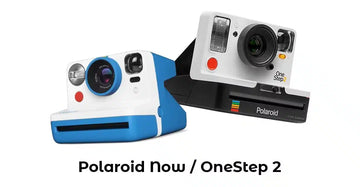Mastering Exposure: Pro Tips for Stunning Vintage Polaroid 600 Shots
by Дашка Шипунова on Jul 28, 2025

As a passionate vintage Polaroid 600 photographer, I know the importance of nailing your exposure to capture those iconic, perfectly-balanced instant shots. Whether you're a seasoned pro or just starting out, getting the exposure right can be a game-changer when it comes to the quality and aesthetic of your Polaroid images.
In this comprehensive guide, I'll share my top pro tips for achieving perfect exposure on your vintage Polaroid 600 camera. From understanding how the electric eye meter works to techniques for dealing with tricky lighting scenarios, you'll walk away with the knowledge and confidence to take your Polaroid photography to the next level.
The Polaroid 600 Exposure System Explained
At the heart of your Polaroid 600 camera is an electric eye exposure system that automatically sets the shutter speed and lens aperture based on the lighting conditions in the scene. This clever little mechanism is designed to take the guesswork out of exposure, allowing you to focus on composing your shot rather than fiddling with camera settings.
Here's how it works: the electric eye measures the amount of light in the scene and adjusts the exposure accordingly. If the scene is brightly lit, the electric eye will set a faster shutter speed and smaller aperture to prevent the image from being overexposed. Conversely, in low-light conditions, the electric eye will slow down the shutter speed and open the aperture to let in more light and avoid an underexposed shot.
While this automatic exposure system is incredibly convenient, it's not infallible. Certain lighting scenarios can trick the electric eye, leading to unevenly exposed images where the subject is too dark or the background is too bright. That's where my pro tips come in to help you master exposure and consistently capture perfectly balanced Polaroid shots.
Dealing with Uneven Lighting
One of the most common exposure challenges with Polaroid 600 cameras is dealing with uneven lighting in the scene. If the background is significantly brighter or darker than your subject, the electric eye can get confused and set the exposure incorrectly.
Bright Background, Dark Subject
If the background in your scene is a large part of the frame and significantly brighter than your subject, the electric eye will prioritize the background exposure. This means the camera will set the exposure to properly expose the bright background, leaving your subject underexposed and too dark.
To overcome this, I recommend getting in close to your subject and filling more of the frame with them. This will help the electric eye focus on the subject rather than the bright background, ensuring your main point of interest is properly exposed. You can also try positioning your subject in an area of the frame that is more evenly lit compared to the background.
Dark Background, Bright Subject
The opposite scenario can also occur, where the background is significantly darker than your brightly lit subject. In this case, the electric eye will prioritize the darker background, leading to an overexposed and washed-out subject.
To fix this, again try to get in closer to your subject and minimize the amount of darker background in the frame. You can also experiment with partially blocking the electric eye sensor to trick it into setting a lower exposure and preventing the subject from being blown out.
Mastering Exposure Compensation
While the Polaroid 600's automatic exposure system is generally reliable, there may be times when you need to take manual control and make adjustments to get the perfect shot. This is where exposure compensation comes in handy.
Most Polaroid 600 models feature an exposure compensation dial or slider that allows you to fine-tune the exposure in increments of +/- 1 or 2 stops. By adjusting the exposure compensation, you can override the electric eye's automatic settings and intentionally underexpose or overexpose the image to achieve your desired look.
For example, if you're shooting a backlit subject and the electric eye is overexposing the image, you can dial in some negative exposure compensation to darken the shot and properly expose your subject. Conversely, if your subject is in shadow and the camera is underexposing, you can apply some positive compensation to brighten things up.
It's worth noting that exposure compensation is a bit of a trial-and-error process, so I recommend bracketing your shots by taking the same image at different compensation levels. This will allow you to see the results and determine the perfect exposure for your particular scene and lighting conditions.
Shooting Techniques for Consistent Exposure
In addition to understanding how to use exposure compensation, there are a few key shooting techniques I've found helpful for consistently nailing the exposure on my vintage Polaroid 600 camera:
- Get in Close: As mentioned earlier, filling more of the frame with your subject and minimizing the background can help the electric eye meter the exposure correctly. This is especially important in high-contrast scenes.
- Avoid Backlighting: Shooting with the light source behind your subject can easily fool the electric eye and lead to underexposed shots. Try to position your subject so the light is coming from the side or front instead.
- Use the Polaroid 636 Close-Up: If your Polaroid 600 model has a close-up lens attachment, like the Polaroid 636 Close-Up, using it can help you get in tighter on your subject and avoid exposure issues caused by the background. You can find the Polaroid 636 Close-Up on Amazon.
- Experiment with Exposure Compensation: Don't be afraid to use the exposure compensation dial or slider to fine-tune the exposure and get the look you want. Bracket your shots to find the sweet spot.
- Pay Attention to the Electric Eye: Keep an eye on the electric eye sensor and make sure it's not being obstructed or influenced by your hand or other elements in the scene. This can help ensure the automatic exposure is working as intended.
Polaroid 600 Film and Exposure
Another important factor to consider when it comes to exposure on your Polaroid 600 is the film itself. Different types of Polaroid 600 film can have varying sensitivity to light, which can impact the exposure and overall look of your images.
For example, Polaroid 600 color film tends to be more forgiving of exposure variations compared to black-and-white films, which can be more sensitive to over or underexposure. Experimenting with different film stocks and paying attention to their exposure characteristics can help you fine-tune your technique and get the results you're after.
It's also worth noting that vintage Polaroid 600 cameras may have slightly different exposure systems compared to newer models. If you're using an older camera, you may need to adjust your approach and be a bit more hands-on with exposure compensation to achieve consistent results.
Putting it All Together: Exposure Mastery for Polaroid 600
Mastering exposure on your vintage Polaroid 600 camera is all about understanding how the electric eye meter works, recognizing common lighting challenges, and developing a repertoire of techniques to overcome them. By following the tips and strategies I've outlined in this guide, you'll be well on your way to consistently capturing perfectly exposed, vibrant Polaroid shots that showcase the unique character of this iconic instant film format.
Remember, the key is to experiment, bracket your shots, and pay close attention to the results. With a little practice, you'll be a Polaroid exposure pro in no time. Happy shooting!
For more tips and resources on using your vintage Polaroid 600 camera, be sure to check out our website and shop our recommended Polaroid accessories on Amazon.




